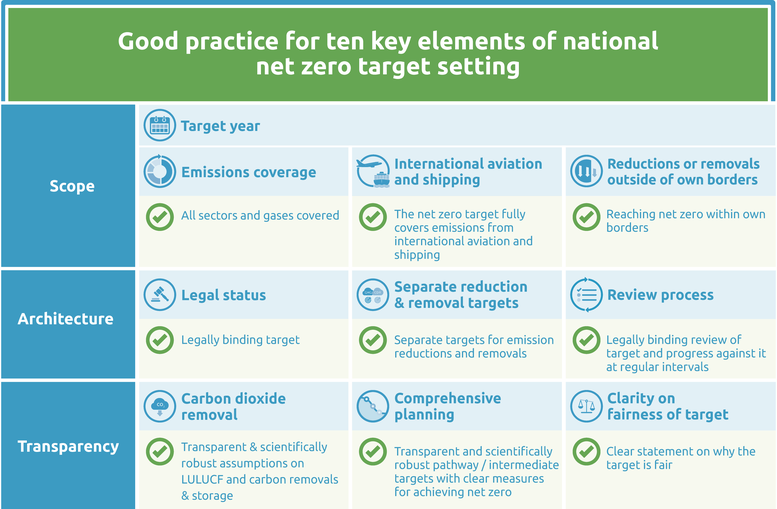Net zero targets
Summary
We evaluate the net zero target as: Average.
Canada passed the Canadian Net-Zero Emissions Accountability Act in June 2021, which enshrines its 2050 net zero target into law. The Act also mandates the setting of intermediary targets at five-year intervals (2030, 2035, 2040, 2045), at least a decade in advance of each target, and several reporting requirements. The first Emissions Reduction Plan with targets for 2030 was published in March 2022 and the first progress report on it in 2023 with more reports planned for 2025 and 2027 (Environment and Climate Change Canada, 2022a, 2023a).
Canada updated its long-term strategy in October 2022. The strategy explores a number of different scenarios capable of achieving net zero emissions in 2050, but does not set a particular pathway for the country to follow, nor does it outline the policies and measures needed to achieve the target. Reliance on LULUCF and other CDR in 2050 could be as high as 45% of Canada’s emissions in 2020 (or 301 MtCO2e). Under all scenarios, Canada is still producing and exporting oil and gas in 2050.
While Canada’s Net-Zero Act includes some positive measures, it does not follow good practice identified by the Climate Action Tracker on a number of other aspects, such as including emissions from international aviation and shipping into its target nor committing to achieve the entirety of the target through emissions reductions in Canada.
CAT analysis of net zero target
Ten key elements
Scope
- Target year – Canada aims to reach net zero by 2050, however, nothing in its Net-Zero Act precludes achieving net zero emissions before 2050.
- Emissions coverage – The target covers all GHG emissions and all sectors of the economy (excluding international bunkers).
- International aviation and shipping – The target does not cover international aviation and shipping. However, under the Net-Zero Act, it is possible to amend the coverage in future. Although not covered officially in the Act, or in Canada’s long-term strategy, Canada’s updated Aviation action plan (September 2022) covers both domestic and international aviation emissions and Canada reported on its activities related to both domestic and international aviation and shipping as part of its first progress report under the Act.
- Reductions or removals outside of own borders – The scenarios explored in Canada’s updated LTS focus on achieving net zero emissions through domestic action; however, Canada notes that it may use reductions or removals outside of its borders (achieved through the purchase of Internationally Transferred Mitigation Outcomes) to meet its net zero target in 2050.
Target architecture
- Legal status – Canada passed its net zero target into law in June 2021 (Government of Canada, 2021e). It submitted an updated LTS to the UNFCCC in October 2022.
- Separate reduction & removal targets – Canada does not have separate emissions reduction and removal targets. It does provide information on its LULUCF assumptions and possible reliance on DACCS and BECCS in its 2022 LTS update. The LULUCF contribution is defined ex-ante and constant across all modelling approaches, whereas the extent of CO2 removal technology usage is defined by the models.
- Review process – Canada must prepare progress reports on its intermediary five-year targets. However, there is no binding obligation to achieve the targets, only to explain why the target was not reached and to provide a description of the actions being taken in case of failure (Environment and Climate Change Canada, 2022a). We have downgraded our previous rating of this element because Canada’s Net-Zero Act does not require the review of the net zero target itself but rather the milestone targets on the way to net zero in 2050.
Transparency
- Carbon dioxide removal – Canada’s long-term strategy clearly includes reliance on LULUCF and other CO2 removal technology across the scenarios it considers. The LULUCF contribution is set ex-ante and consistent across all models, whereas the level of CO2 removal technology usage varies across the scenarios. The LULUCF contribution is set at 100 MtCO2e or 15% of Canada’s 2020 emissions, while CDR usage by 2050 is as high as 34% of the country’s 2020 emissions in some scenarios.
- Comprehensive planning – Canada updated its long-term strategy in October 2022. The strategy explores a number of different scenarios capable of achieving net zero emissions in 2050, but does not set a particular pathway for the country to follow or outline the policies and measures needed to achieve its net zero target.
Under the Net-Zero Act, the government is required to set an interim reduction target for 2026. The government established this target as 20% below 2005 levels, but does not consider this to be an official target (like its NDC), just a metric to measure progress against.
In February 2021, the government established an advisory body to assist it in developing net zero pathways (Government of Canada, 2021g). The 2021 Budget included five years of funding for Environment and Climate Change Canada to develop and apply a ‘climate lens’ to federal decision-making processes (Government of Canada, 2021b).
- Clarity on fairness of target – The updated LTS does not provided an explanation for why Canada’s net zero target is a fair contribution to meeting the Paris Agreement’s 1.5°C limit. Under the Net Zero Act, the government must consider Canada’s international commitments under the Convention and Paris Agreement.
Good practice
The Climate Action Tracker has defined the following good practice for all ten key elements of net zero targets. Countries can refer to this good practice to design or enhance their net zero targets.
Further analysis
Latest publications
Stay informed
Subscribe to our newsletter







